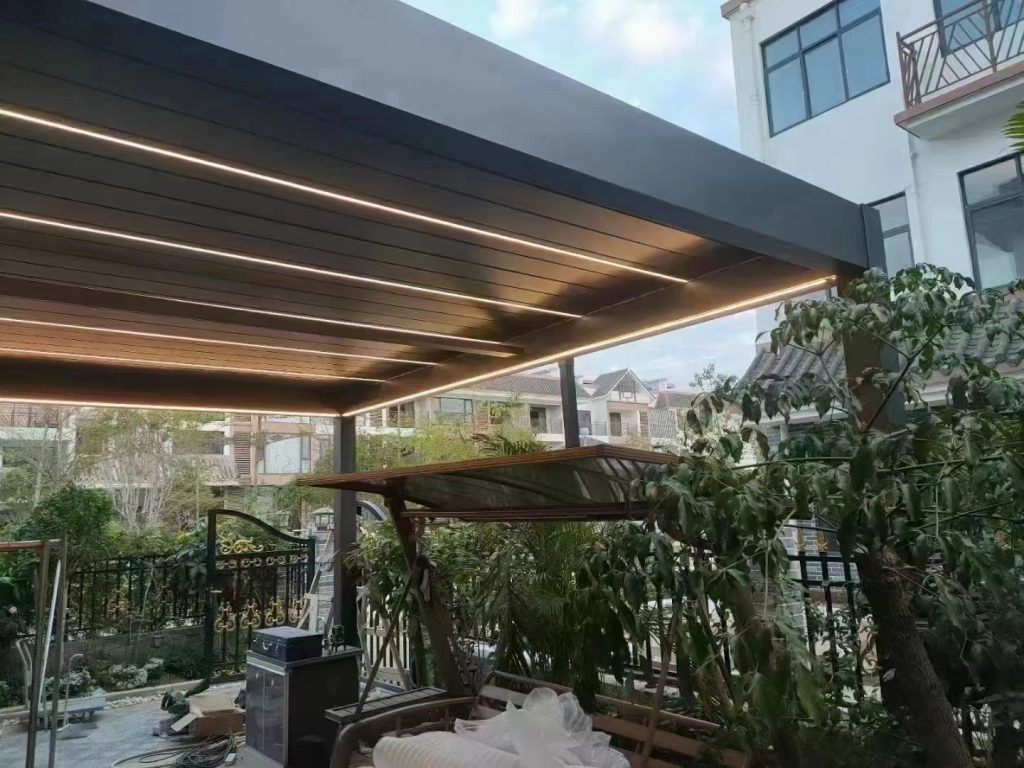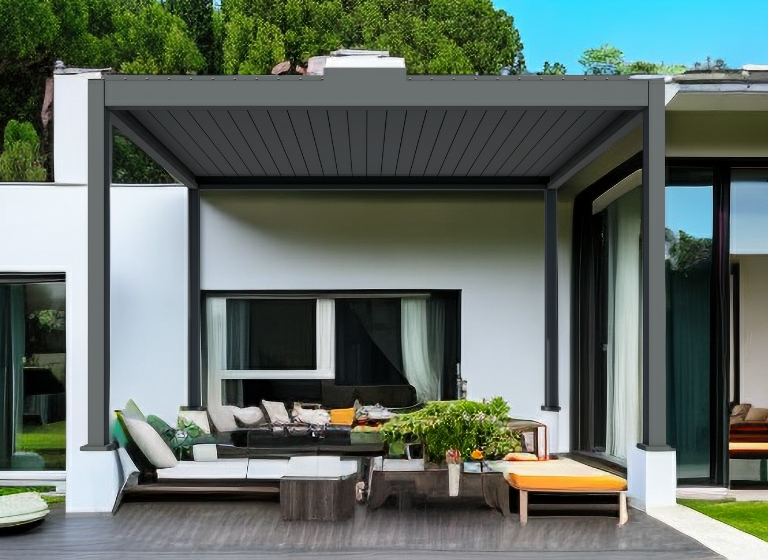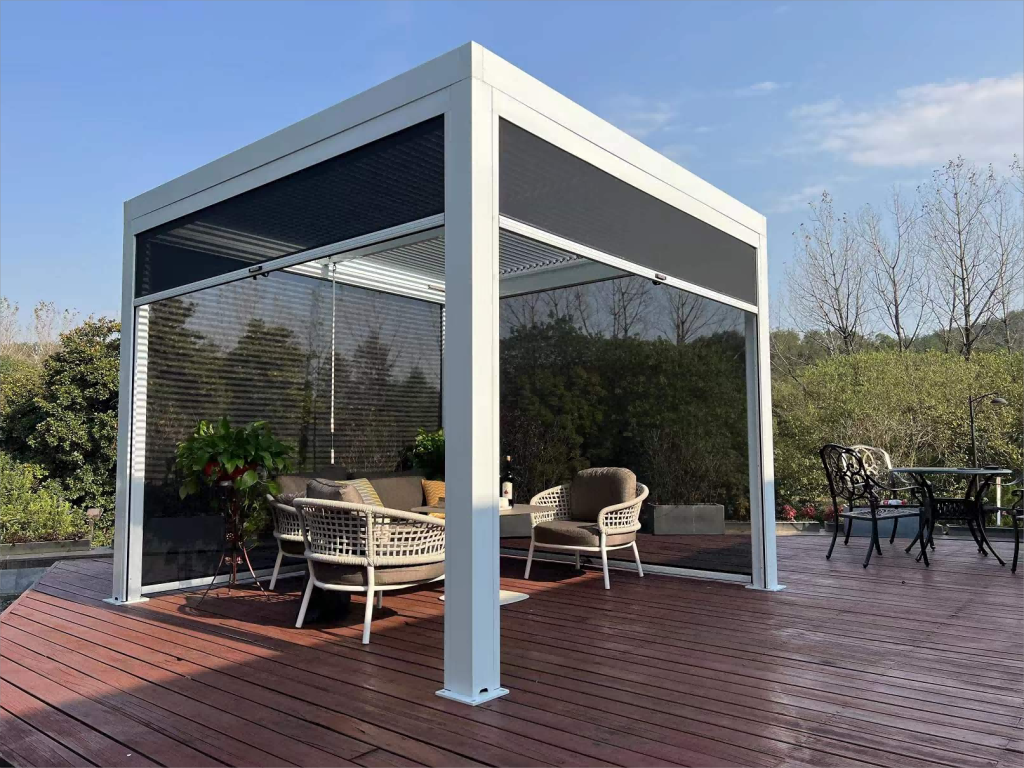Pergola kit are a popular architectural element in garden and outdoor space design, offering both aesthetic appeal and functional benefits. One of the primary functions of a pergola is to provide shade, but the extent to which a bioclimatic pergola can block the sun depends on several factors including its design, materials, placement, and additional shading solutions. In this comprehensive article, we will explore these factors in detail, focusing on the types of pergolas, their construction, shading effectiveness, and ways to enhance their sun-blocking capabilities.
Types of Pergola Kit
There are two main structural styles of pergolas: fixed pergolas with a static open lattice top, and aluminum pergolas with adjustable louvered blades. Each type has its own set of characteristics and advantages.
Fixed Pergolas
Fixed pergolas typically feature a frame with a lattice or grid-like top that allows sunlight to filter through. These structures can be made from various materials, including wood, vinyl, and metal. The amount of shade they provide depends largely on the angle and position of the sun throughout the day.
- Wooden Pergolas: Wooden pergolas are a classic choice, offering a natural and rustic look. They are usually made from durable woods like cedar, redwood, or pressure-treated pine. While aesthetically pleasing, the fixed nature of their slats means they provide partial shade and cannot be adjusted to block the sun completely.
- Vinyl Pergolas: Vinyl pergolas require less maintenance than wood and offer a clean, modern appearance. They are resistant to rot, peeling, and cracking. However, like wooden pergolas, the fixed slats limit their ability to provide complete shade.
- Metal Pergolas: Made from materials like aluminum or steel, metal pergolas are durable and can be designed with a more contemporary aesthetic. They often have a sleek, industrial look. The fixed slats of metal pergolas also offer partial shade.
The shading effect of fixed pergolas is heavily influenced by the sun’s angle. During midday, when the sun is directly overhead, the slats provide minimal shade, allowing a significant amount of sunlight to pass through. The position and spacing of the slats can be optimized to enhance shading, but complete sun blockage is generally not achievable without additional shading elements.
Aluminum Pergolas with Louvered Blades
Aluminum pergola kits with louvered blades represent a more advanced and versatile shading solution. The blades in these pergolas can be adjusted, either manually or electronically, to control the amount of sunlight that passes through. This adjustability makes them highly effective for managing shade throughout the day.
- Adjustable Blades: The key feature of these pergolas is the ability to adjust the angle of the blades, which can typically rotate up to 120 degrees. This allows users to customize the shading according to their preference and the position of the sun.
- Manual vs. Motorized: Louvered blade pergola kits can come with manual adjustment mechanisms or motorized systems. Motorized systems offer convenience and can be controlled via remote, smartphone apps, or even integrated into home automation systems.
- Material Benefits: Aluminum is a lightweight yet strong material, resistant to rust and corrosion, making it ideal for outdoor structures. It requires minimal maintenance and can withstand various weather conditions.

The louvered blades can be set to various positions to either allow sunlight in, provide partial shade, or completely block the sun. This flexibility makes aluminum pergolas with louvered blades suitable for different times of the day and varying weather conditions.
For instance, in the morning, the blades can be left open to enjoy the gentle sunlight. During the peak of the afternoon, the blades can be closed to provide complete shade and protect against harmful UV rays.
In the evening, the blades can be adjusted to let in the fading sunlight while maintaining a comfortable environment.
Factors Affecting Shading Effectiveness
The effectiveness of a pergola in providing shade depends on several factors, including its design, placement, and the use of additional shading solutions.
Design Considerations
- Slat Orientation and Spacing: For fixed pergolas, the orientation and spacing of the slats play a crucial role in determining the amount of shade provided. Angling the slats can help in blocking more sunlight during specific times of the day. Closer spacing between slats increases the shaded area but can reduce ventilation and light.
- Height of the Pergola: The height at which the pergola is installed affects its shading capability. A higher pergola kit might allow more sunlight to filter through, whereas a lower pergola can provide more concentrated shade.
- Pergola Size and Coverage Area: Larger pergola can cover more area, providing shade to a bigger space. However, the size and shape of the pergola should be proportional to the space it is intended to shade to ensure effectiveness and aesthetic harmony.
Placement and Orientation
- Sun Path: Understanding the sun’s path is essential for optimizing the placement and orientation of the pergola kit. In the Northern Hemisphere, positioning the pergola with an orientation that considers the southern exposure can maximize shade during peak sun hours. Conversely, in the Southern Hemisphere, northern exposure is preferred.
- Surrounding Structures: The presence of nearby buildings, trees, or other structures can impact the shading effectiveness. These elements can cast additional shadows or reflect sunlight, influencing the overall shading pattern.
- Local Climate: The local climate and typical weather conditions should be taken into account. In regions with intense sunlight and high temperatures, maximizing shade is crucial, whereas in cooler climates, allowing some sunlight can help maintain warmth and comfort.
Enhancing Pergola Shading with Additional Solutions
To achieve complete shading, especially during the early morning and late afternoon when the sun is at a lower angle, additional shading solutions can be employed alongside the pergola.
Blinds and Roller Shutters
- Vertical Blinds: Attaching vertical blinds to the sides of the pergola can block low-angle sunlight while allowing ventilation. These blinds can be adjusted to control the amount of light and air passing through.
- Roller Shutters: Roller shutters offer a robust solution for blocking sunlight, wind, and rain. They can be rolled up or down as needed, providing flexibility in managing the outdoor environment.
- Motorized Options: Similar to louvered blades, blinds and shutters can be motorized for ease of use, allowing for quick adjustments based on changing weather conditions.
Shade Sails and Canopies
- Shade Sails: Shade sails are tensioned fabric structures that can be attached to the pergola to provide additional shade. They are available in various shapes, sizes, and colors, and can be positioned to block sunlight from specific directions.
- Retractable Canopies: Retractable canopies offer adjustable shading options. These canopies can be extended or retracted manually or via motorized systems, providing shade when needed and opening up the space when more sunlight is desired.
Plants and Greenery
- Climbing Plants: Using climbing plants like vines, wisteria, or ivy can enhance the natural shade provided by a pergola. These plants grow over the pergola, creating a living canopy that not only provides shade but also adds to the aesthetic appeal.
- Potted Plants and Planters: Strategically placing potted plants and planters around the pergola can create additional shaded areas. Tall plants and those with broad leaves can block sunlight effectively.
Practical Applications and Benefits of Pergolas
Pergolas are versatile structures that can be used in a variety of settings, each benefiting from the combination of shade, aesthetic enhancement, and functional space creation.
Residential Settings
- Backyard Retreats: Pergolas can transform backyards into relaxing retreats. By providing a shaded area for seating, dining, or lounging, they enhance the usability of outdoor spaces.
- Poolside Pergolas: Installing a pergola near a pool can create a comfortable area for relaxation, shielding swimmers from the harsh sun while maintaining an open and airy feel.
- Garden Features: Pergolas can serve as focal points in gardens, supporting climbing plants and creating picturesque walkways or entryways.
Commercial and Public Spaces
- Restaurant Patios: Restaurants can use pergolas to extend their seating areas outdoors, offering patrons a shaded and pleasant dining experience.
- Parks and Recreational Areas: Pergolas in public parks and recreational areas provide shaded resting spots for visitors, enhancing the usability of these spaces during hot weather.
- Retail Spaces: Outdoor shopping areas and malls can benefit from pergolas, creating shaded walkways and seating areas for shoppers.
User Experiences and Case Studies
To understand the practical impact of pergolas, let’s explore some real-life examples and user experiences.
Case Study 1: Residential Pergola Transformation
A homeowner in California installed an aluminum pergola kit with motorized louvered blades over their backyard patio. The adjustable blades allowed the family to enjoy breakfast in the morning sun, complete shade during hot afternoons, and a gentle sunset in the evening. The addition of vertical blinds on the sides provided extra shade and privacy, making the space versatile and comfortable throughout the day.
Case Study 2: Restaurant Patio Enhancement
A restaurant in Florida expanded its outdoor seating with a fixed pergola kit made of vinyl. To enhance shading, the owner added retractable shade sails that could be adjusted based on the sun’s position. This setup not only increased seating capacity but also attracted more customers who preferred dining outdoors without the intense sun. The restaurant reported a 20% increase in revenue during the summer months.
Case Study 3: Public Park Improvement
A community park in Texas installed several wooden pergolas in picnic areas. The pergolas were adorned with climbing plants, creating natural shade.



Very interesting information!Perfect just what I was
searching for!Blog monry